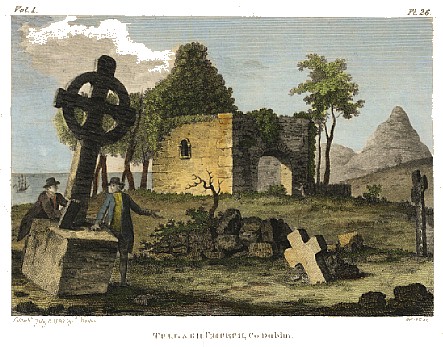
St Brigid's Cross - Symbol of St Brigid
dedicated to St Brigid
Cabinteely, Co Dublin Ireland
 Situated in the townland of Lehaunestown, these ruins consist of a roofless chancel, with its fine round arch in perfect order, and the outline of the nave, which is completely down. The chancel, which is wider than the nave, was added in the late 12th or early 13th century by the Normans. The church was dedicated to St. Brigid, and there is a legend told in the Book of Lismore of how seven holy men or chorepiscopi (cabhaireaspaig? - bishop's helpers?) set out from Tulagh-na-nEpscop (Tulach na nEaspag) or the Hillock of the Bishops to visit St. Brigid in Kildare and were miraculously provided with refreshment. There are many connections between Tully and St. Brigid of Kildare. If indeed Tully was founded by her, this church must go back to the early 6th century as St. Brigid died in 523 A.D. However, the patroness of Tully could be a Brigid commemorated in the Martyrology of Donegal on March 6th, "Brigid, daughter of Léinín at Cill Ingen-Leinin (Cill Iníonn Léinín) in Uí Briuin Cualann (District of South Co Dublin north of Bray Head and Sugarloaf Mountain or Sliabh Chualann)" and, thus, sister of the five holy ladies of Killiney Church. In 1179, after the Norman conquest, Tully was granted to the Priory of the Holy Trinity by St Laurence O'Toole. In 1615 it is recorded as 'in ruins, completely waste - thrown down'. After the 1641 Rebellion the church was not used again. The above drawing appears in Grose's "Antiquities" dated 1790. Two of the Crosses are still extant at the site. A third, small and quite plain in the foreground centre, has completely disappeared. The custom of an interfaith pilgrimage to this site has started recently. The next pilgrimage is planned on 21st May 2000.
|